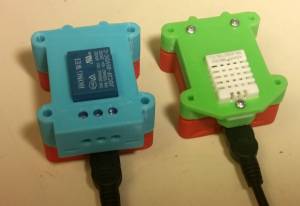This is an old revision of the document!
Smart ventilator example
This example shows how to make a temperature sensor controlled ventilator. You will need 2 controller modules. One with DHT shield attached and the other with relay shield.
Once the code has been uploaded, the DHT controller will publish the temperature and humidity values to “temp” and “hum” every 2 seconds. The relay module subscribes to topics “temp” and “conf”. The relay controller will switch the relay if the temperature rises above the set limit (default:28 degrees). To change the set limit, send a new value to the “conf” topic. (For example: “25.5”)
The following is the code for the controller with relay module. Required libraries:
lib_deps = ITTIoT@1.0.5
#include <Arduino.h> #include <ittiot.h> // Change it according to the real name of the red IoT module where // DHT shield is connected #define DHT_TOPIC "ESP53" #define RELAY_PIN 5 float t; //for holding the received float value float tempLimit = 28; //the temperature limit on what the relay will switch // Message received void iot_received(String topic, String msg) { t=msg.toFloat(); // Check if topic contains conficuration data if(topic == (DHT_TOPIC"/conf")) { //re-configures the limit temperature tempLimit=t; } // Check if topic contains temperature data if(topic == (DHT_TOPIC"/temp")) { // Relay switching according to the temperature limit value if(t >= tempLimit) { digitalWrite(RELAY_PIN, HIGH); } else { digitalWrite(RELAY_PIN, LOW); } } } // Function started after the connection to the server is established. void iot_connected() { // Send message to serial port to show that connection is established Serial.println("MQTT connected callback"); // Subscribe to get temperature and temperature configuration messages iot.subscribe(DHT_TOPIC"/temp"); iot.subscribe(DHT_TOPIC"/conf"); // Send message to MQTT server to show that connection is established iot.log("Ventilator example!"); } void setup() { // Initialize serial port and send message Serial.begin(115200); Serial.println("Booting"); // print IoT json config to serial iot.printConfig(); // Initialize IoT library iot.setup(); // Initialize relay pin as output pinMode(RELAY_PIN, OUTPUT); } void loop() { // IoT behind the plan work, it should be periodically called iot.handle(); delay(200); }
The following is the program code for the controller with DHT module. Required libraries:
lib_deps = ITTIoT@1.0.5, DHT sensor library, Adafruit Unified Sensor
#include <Arduino.h> #include <ittiot.h> #include <DHT.h> #define DHTPIN D3 // Pin where DHT shield is connected. Change this to D4 if your shield has no legs removed. #define DHTTYPE DHT22 // DHT 22 (AM2302) // Create an object for DHT sensor DHT dht(DHTPIN, DHTTYPE); // Message received void iot_received(String topic, String msg) { } // Function started after the connection to the server is established. void iot_connected() { // Send message to serial port to show that connection is established Serial.println("MQTT connected callback"); // Send message to MQTT server to show that connection is established iot.log("IoT DHT example!"); } void setup() { // Initialize serial port and send message Serial.begin(115200); Serial.println("Booting"); // print IoT json config to serial iot.printConfig(); // Initialize IoT library iot.setup(); // Initialize DHT library dht.begin(); } void loop() { // IoT behind the plan work, it should be periodically called iot.handle(); // Read humidity and temperature float h = dht.readHumidity(); float t = dht.readTemperature(); // Create a buffer to store strings to being sent later char buf[10]; // Convert messages to strings and send to the MQTT server String(t).toCharArray(buf,10); iot.publishMsg("temp",buf); delay(1000); String(h).toCharArray(buf,10); iot.publishMsg("hum",buf); delay(1000); }


